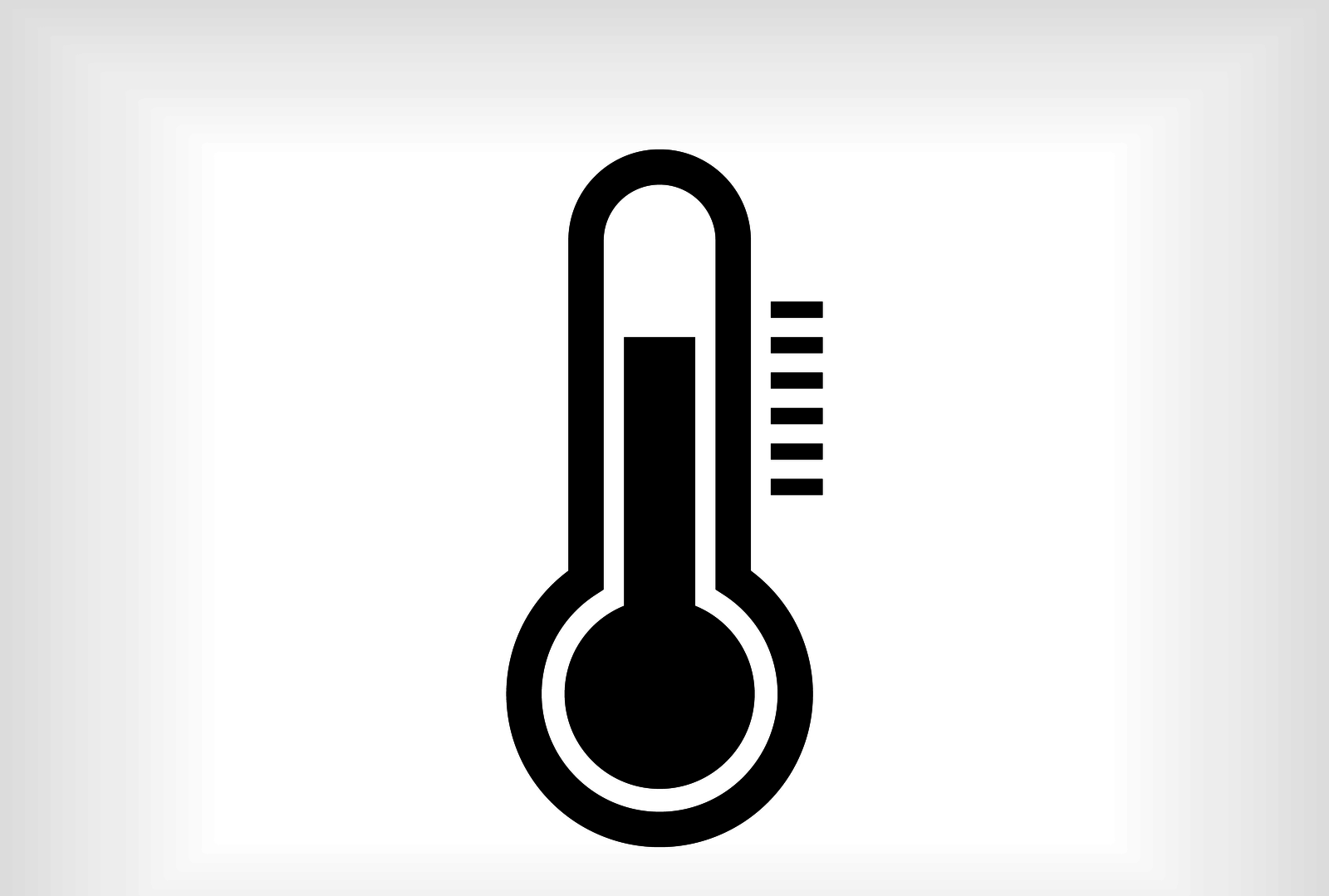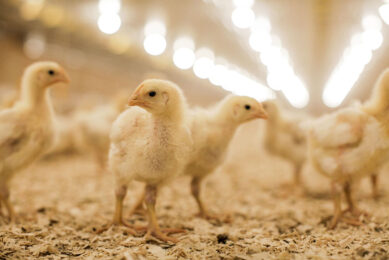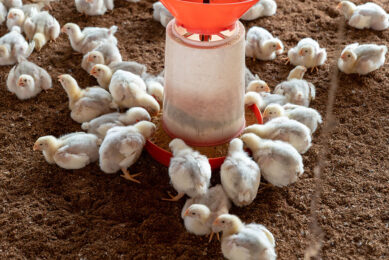The heat is on…

To make feed safe and more cost effective, heat is often used in the conditioning phase during pelleting, a process which demands that any additives used are thermostable. There is a trend towards using additives which are ?inherently thermostable or have thermostable coatings. This article looks at the benefits for poultry producers making these choices.
By Ahmed Amerah, innovation scientist, Danisco Animal Nutrition
First introduced in the 1920s, pelleting – the agglomeration of small feed particles in the feed mix to create a higher density end product – is the most common form of thermal treatment in poultry feed. Pelleting per se involves the extrusion of conditioned hot mash through a die of a particular length or diameter. In the conditioner, steam is introduced under pressure which subjects the mash to high temperatures prior to entering the pellet die. These high temperatures reduce the risk of contamination of high risk ingredients in feed, such as oil seed meals, vegetable proteins and animal derived proteins, particularly important in poultry production given that over 50% of all traceable human cases of salmonellosis have been associated with the consumption of poultry products. There is also no shortage of research to back up claims of improve digestibility, increase nutrient intake, reduce feed wastage and decrease energy spent for eating through high quality pellet use.
Heat and loss of nutrients
A wide range of conditioning temperature and retention time combinations are used in the commercial feed milling. Increasing hygiene standards to control feed borne pathogens such as Salmonella have pushed conditioner temperatures to 90 – 95o C (203oF) and sometimes beyond. It is known that higher feed processing temperatures can impact nutrient availability through maillard complexing and loss of vitamins and synthetic amino acids. It is also commonly accepted that frequently used feed additives such as enzymes are susceptible to heat and that are some are more susceptible than others. One way of getting around these issues involves the routine spraying of feed with liquid enzymes after pelleting. Although engineering technology continues to improve dramatically, applying liquid enzymes accurately after pelleting can still be a complex and costly procedure. Accurate application of enzymes, requires specialist spraying equipment which often needs to be designed by an engineer for an individual feed mill. To address these issues and avoid similar issues with the post pelleting addition of dry enzymes, enzyme manufacturers have taken three main approaches:
- Applying coatings that can withstand the degree of heat and moisture created in feed manufacture(Figure 1)
- Genetically modifying the enzyme so it is more inherently thermostable
- Discovering intrinsically thermostable enzymes
Thermostability of the enzyme and quick release in the low pH conditions of the gut is especially important for phytase enzymes as any reduced efficacy will result in reduced phytate degradation with all the negative consequences that entails, including reduced animal performance and welfare.
Coating of phytase
Coatings incorporating Thermo Protection Technology (TPT), first introduced in 2009, ensured that phytase remains active during steam conditioning and subsequent pelleting of feed, saving money and production headaches. Essentially the coating withstands the heat and moisture in the feed mill but can also perform its task effectively in the lower heat and high moisture conditions in the animal. It is also important that the phytase is highly bio-efficacious with an optimal pH level which in broilers should match the proventriculus and gizzard (pH 2.5). In vitro studies clearly show that getting the balance between thermostability and quick release of the enzyme in the right part of the digestive system for optimum bio-efficacy has been a challenge for some feed enzyme manufacturers (Figure 2). TPT also been used to enable high recovery levels of best-in-class carbohydrase and protease products at high temperatures (upwards of 90oC) in pelleted diets.
Bacteria and steam pelleting
But what about heat stability in feed additives other than enzymes? Many poultry producers are looking to improve food safety as well as improving gut health through the inclusion of probiotics such as Bacillus spp. As well as competing for adhesion receptors in the gut epithelium with toxin-producing bacteria and altering metabolism by increasing digestive enzyme activity, certain Bacillus spp. strains have also been shown to contribute to create a positive environment for beneficial bacteria such as Lactobacilli which have been shown to reduce the amount of pathogens such as Salmonella, E. coli, Campylobacter and Clostridium in the gut. Unlike some other probiotics, Bacillus spp. strains can also resist heat and high pressure, helping them survive the hostile steam pelleting process routinely used in the feed industry. This is because when Bacillus spp. encounter a stressful environment (pH, temperature, and nutrient availability), they naturally produce resistant ‘coats’ which are referred to as endospores. The formation of endospores (Figure 3) enables Bacillus spp. strains to resist enzymatic digestion and survive the highly acidic upper digestive tract rich in bile salts. And most of the entire dose of ingested bacteria can reach the small intestine intact. But although probiotics based on Bacillus spp. are known for being resistant to high temperatures, there was, until fairly recently, a scarcity of data to demonstrate their ability to survive typical steam-pelleting conditions used by the poultry feed industry or the subsequent impact that this could have on broiler performance and immune response (taking into account the possible physical and chemical changes caused by the different conditioning temperatures). A recent study was done on 42-day-old broilers fed maize/soy-based diets containing three Bacillus spp. strains.
Effect of pelleting temperature
The results of this trial confirmed the ability of probiotics based on those three strains of Bacillus spp. to tolerate high temperatures under the typical steam pelleting conditions used by the poultry feed industry. The recovery of the probiotic was over 90% across the three pelleting temperatures used (75, 85 and 90oC). There was no effect of pelleting temperature on the performance parameter during the starter phase (1–21 day), but interestingly, over the entire period of 42 days, birds receiving feeds pelleted at 75 and 90°C were heavier than broilers fed 85°C diets. Probiotic supplementation also reduced feed intake by 2.1% and improved feed conversion ratio by 2.3% at 42 day, regardless of pelleting temperature. Supplementation at 75°C also tended to improve the liveability percentage compared to the un-supplemented diet at the same pelleting temperature. In terms of effects on immunity, probiotic supplementation and pelleting at 85 or 90°C increased Secretory IgA (sIgA) – the function which limits the access of numerous micro-organisms and mucosal antigens to thin and vulnerable mucosal barriers in the duodenum – by 61% and 51%, respectively. This study is the first to show that the bird’s mucosal immunity can be influenced by the pelleting temperature in the feed. More recent trials to test pelletising stability of a Bacillus spp. and multi-enzyme combination (Figure 4) showed high levels of recovery for both the Bacillus and enzyme components. (Danisco internal trials 2014).
What does the future hold?
The development of more thermostable enzyme technologies, particularly for multi-enzyme products, will simplify the pre-pelleting application of dry product and promote the use of the enzyme in pelleted diets. New coatings for popular feed enzymes such as phytases will be developed to support further cost savings in production. Discovery of intrinsically thermostable enzymes will continue as the trend towards higher and harsher feed processing to control pathogens such as Salmonella continues. As producers look to use more variable ingredients to reduce production costs and as more attention is focused on animal gut health, it will also be important that any additives added to the mix to support healthy performance and profitability pass the thermostability test. AAF
References available on request, please email: monica.hart@dupont.com
Join 26,000+ subscribers
Subscribe to our newsletter to stay updated about all the need-to-know content in the feed sector, three times a week. Beheer
Beheer











 WP Admin
WP Admin  Bewerk bericht
Bewerk bericht